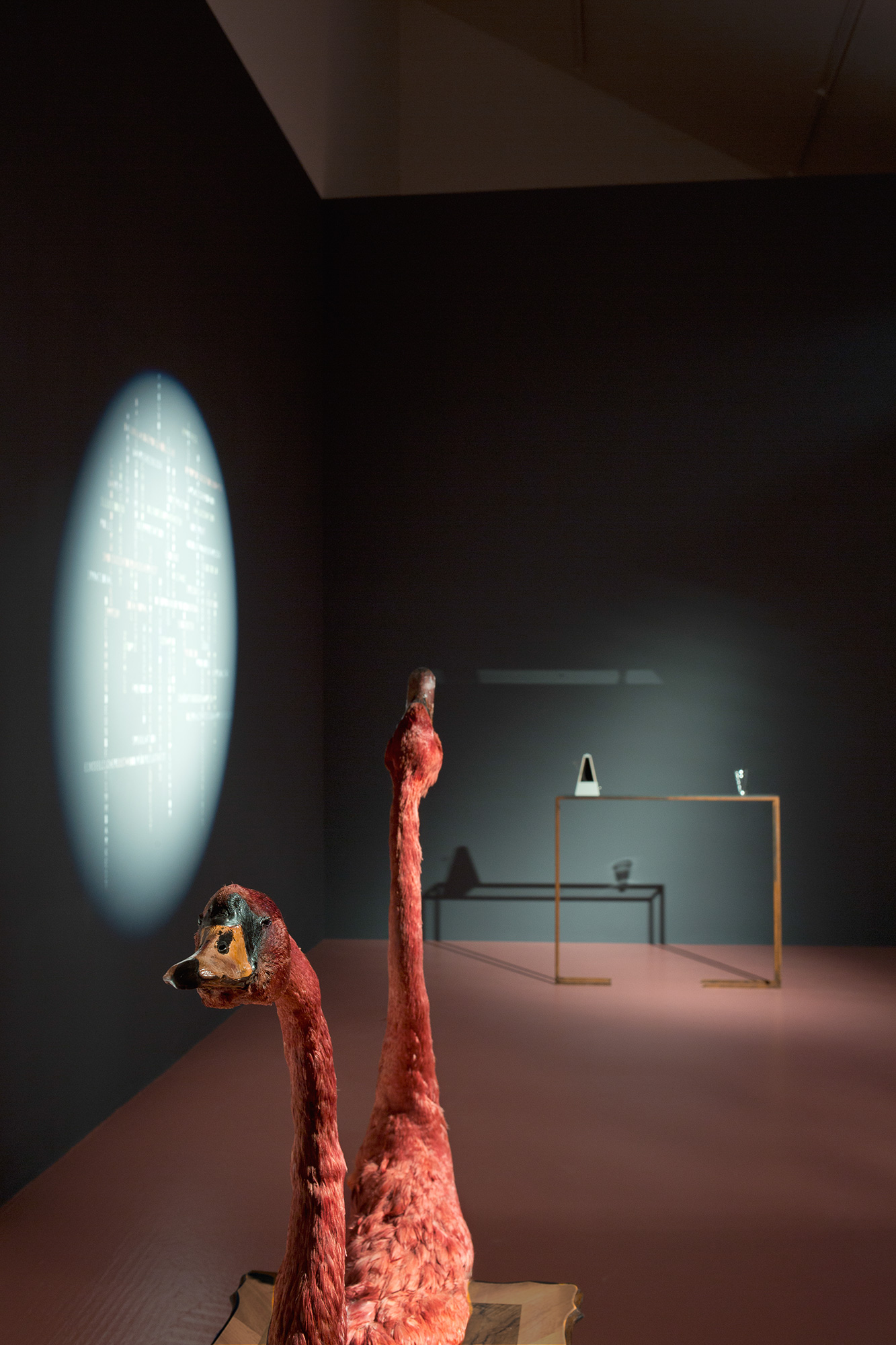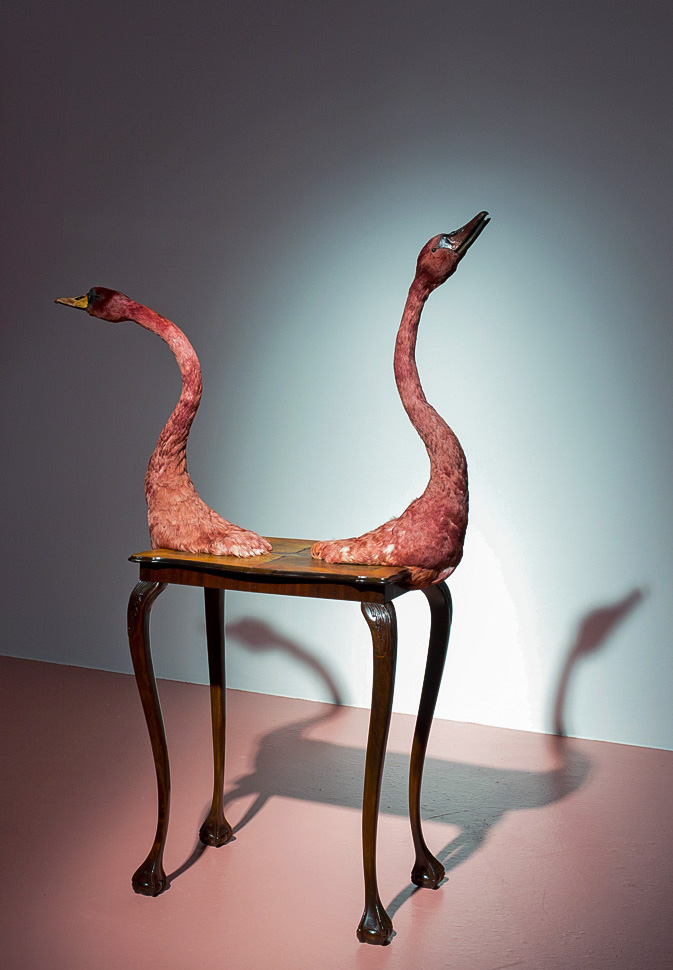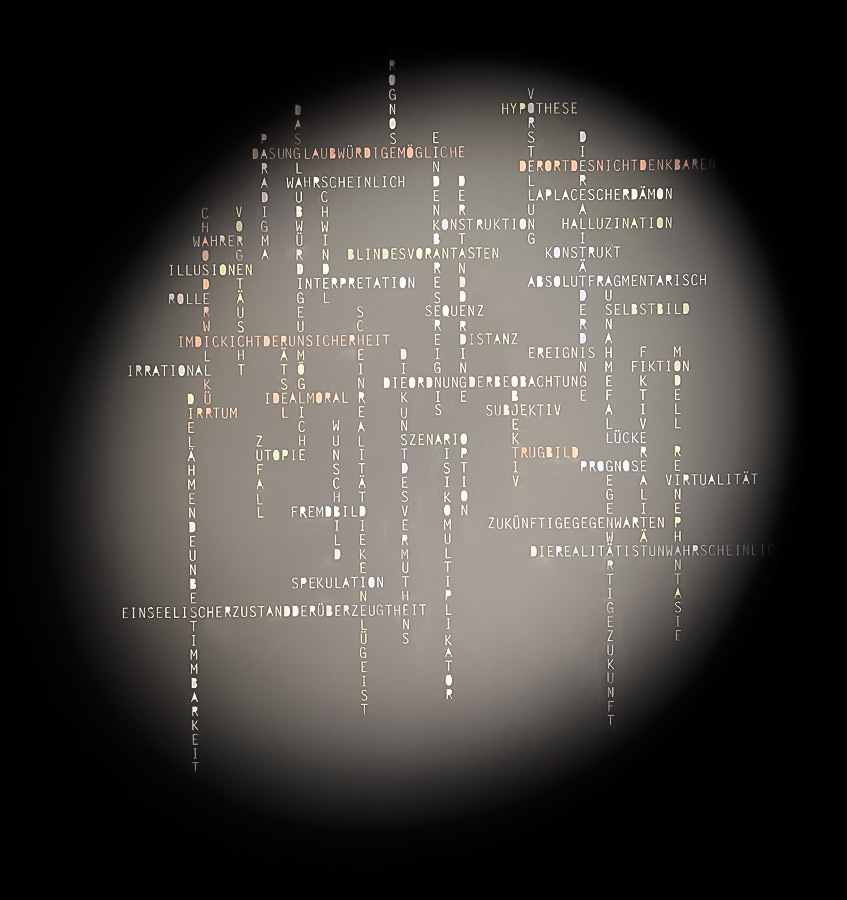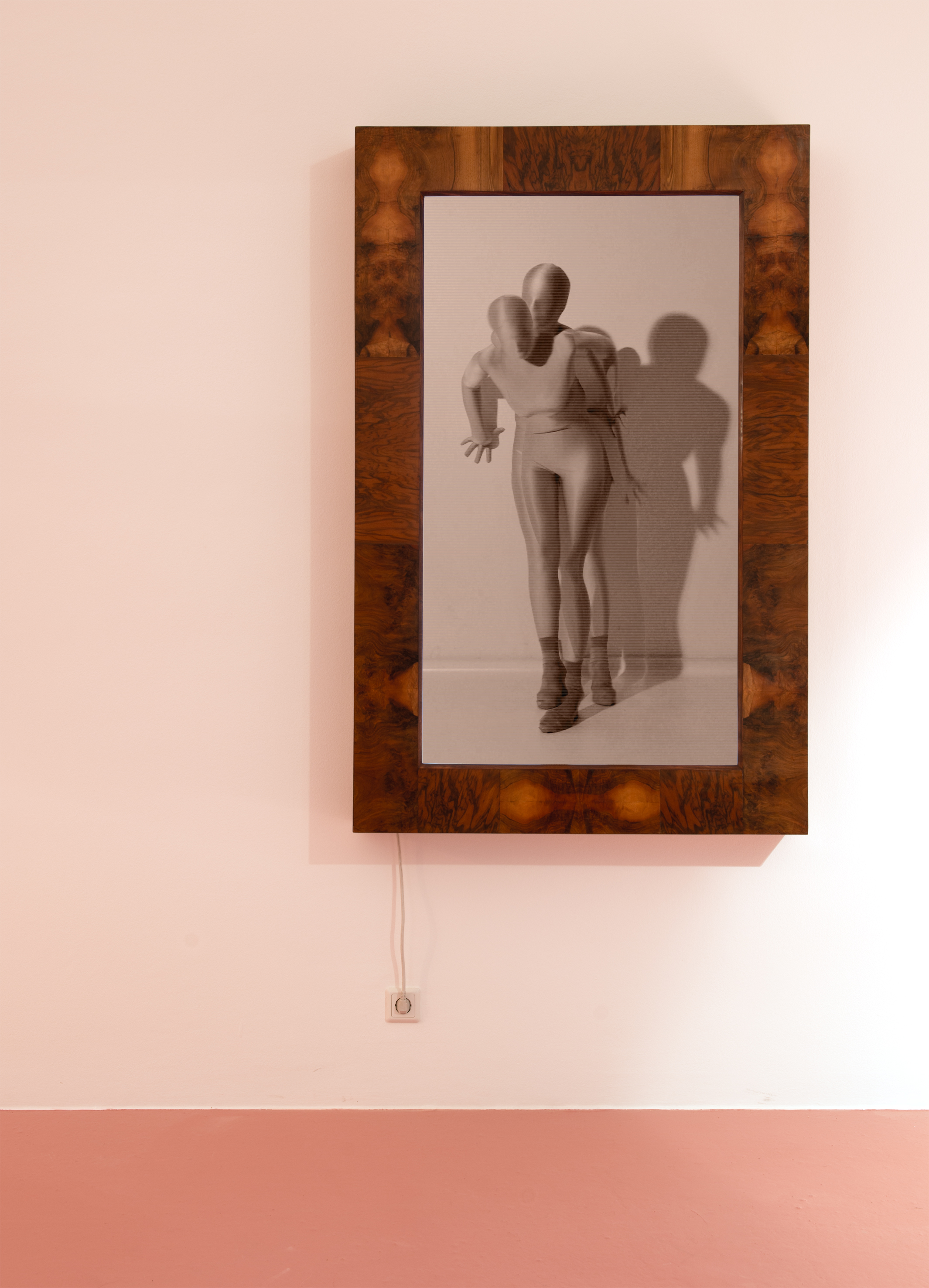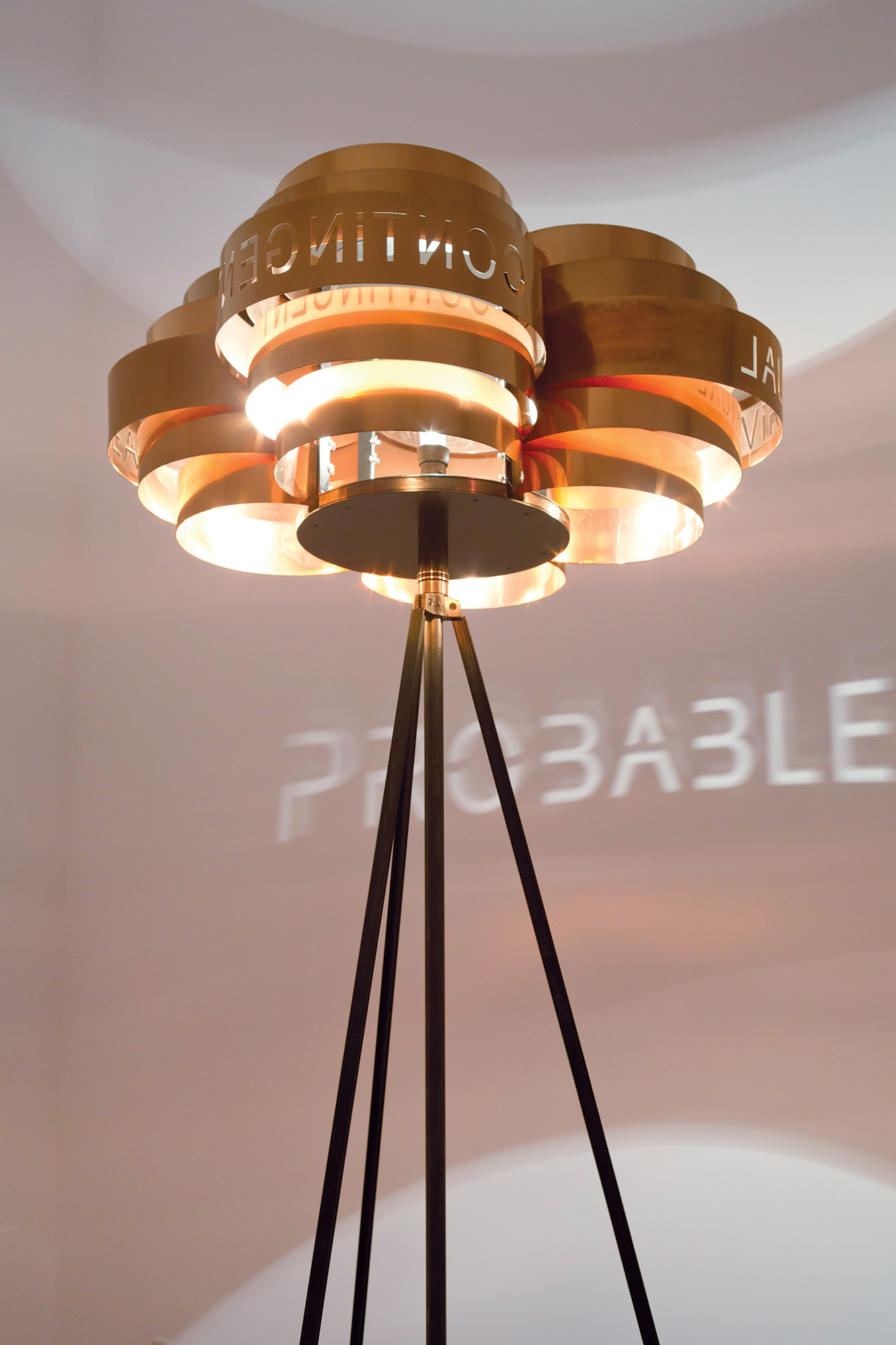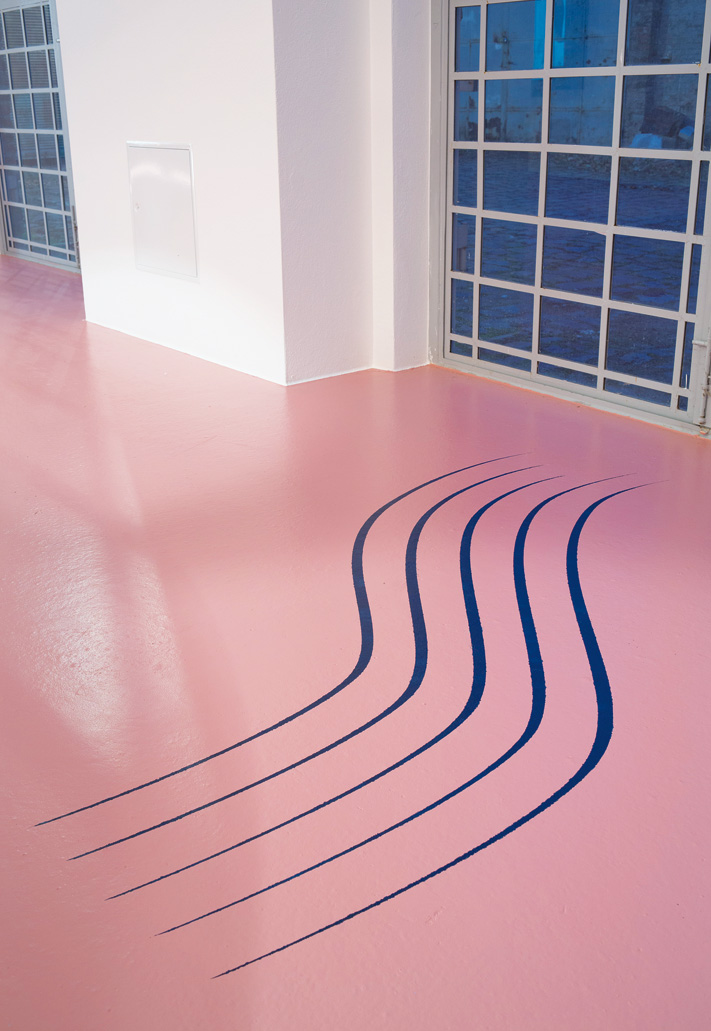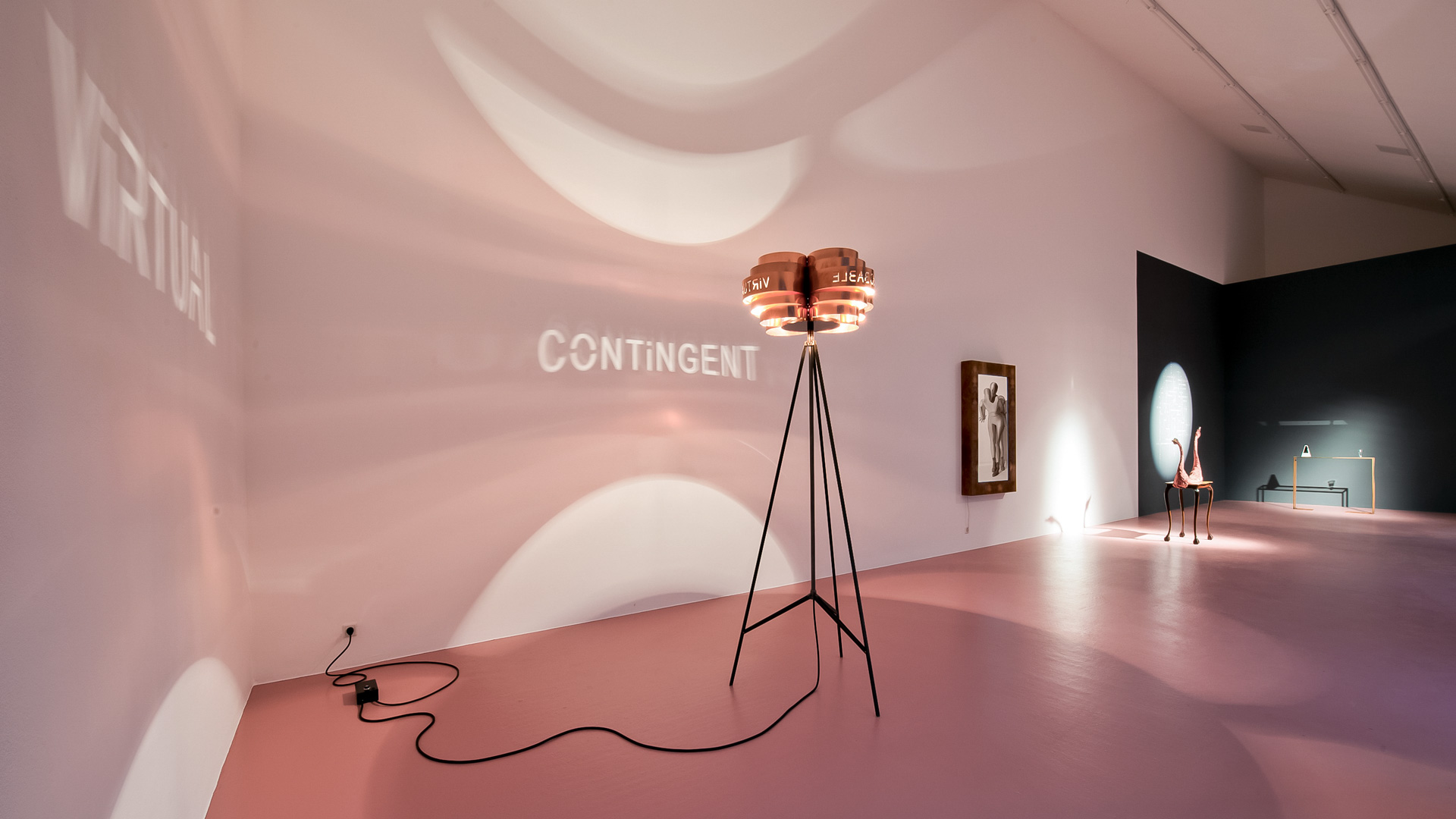
P R O B A B I L I S, installation view, 2012
PROBABILIS
Lucas Gehrmann
The Zero Probability Event, a Frozen Fly, and Two Swans on the Third Table
A Dialectic Tour of Sylvia Eckermann’s Installation Probabilis
REAL, VIRTUAL, PROBABLE, CONTINGENT: a rotating hybrid made of a designer lamp, kinetic object, and projector projects this series of words onto the walls of the exhibition space over and over. If the room were any lighter, the words would not be legible. If the power suddenly were to go out (contingent), they would disappear along with the movement. What might well remain (probably) would be the previously read words in our minds (virtually), and what would still be (real) would be the apparatus as a physically static object.
Shifting States is the title of this light and word machine, which fulfils everything promised by both its name and its output. Provided of course, that some things could be different than they actually are—and it is precisely this option that is inscribed not only in the machine’s title but also explicitly in the adjective “contingent,” a word that regularly appears on the wall, which, taken literally, means more than just “at random”: “Contingency is what is neither necessary nor impossible and therefore could be one way or the other, or that which generally could be but could just as well not be.”1 Here, in the (real) exhibition room, this possible spectrum of being this way, that way, or not at all is present as a form of possibility because, in constant transfer with the three other states, it is not present before us in a singular or definite way. It could be said that in this case the contingent (which in recent philosophical discourse has taken on a high priority) remains continually related to the three other “ontological” possibilities, i.e., the real, the virtual, and the probable, and vice-versa. Based on just a few words and with a minimal degree of technical expenditure, the “Eckermann Modalograph”2 (as I would like to call the light and word machine) fills the room with a scaffolding of complex theoretical concepts referring to the general subject of the construction of truth and reality, linking traditionally opposite modalities and thus raising a great many questions. And almost in passing, the technical-functional aspect of the apparatus is provided with an aesthetic form that reveals its value as a work of art beyond the conceptual level.
This attribute becomes particularly apparent when Sylvia Eckermann’s kinetic sculpture manifests itself as part of the installation entitled Probablis. Here, the sculpture, which on its own already has a lot to say, takes on, as it were, the role of an artistic figure communicating theoretical concepts not just to the other members of the ensemble but also to the audience. In four-quarter time, it emits a single term from its vocabulary to its colleagues in a constant loop, to confront it with the question of its respective state (of being) in ever new ways.
The ensemble includes a spotlighted wall drawing on a black background called Cartography of the Intangible. The “drawing” consists of words and word combinations that, like a crossword puzzle or a coordinate grid, intersect at right angles. This work seems to respond directly to the taciturn “Modalograph” by extracting concepts and notions left unspoken from the interstices in its arrangement of words. So, here, almost to our relief, we find just about anything we consider important with regard to the four big (shifting) states: fiction, event, utopia, self-image, interpretation, speculation, prognosis, construct, pure fantasy, and much more; here also set in uppercase letters, some in white, some in pink and right next to each other in case of word combinations, disappearing into the dark at the edges, that is, in principle open and continuable, but how far and where to? Now and then semantic contexts of words and concepts strike the eye, for instance: the order of observation/subjective/objective/illusion but we to search in vain for a systematic scheme. Instead, priority seems to be given to an associative way of thinking, perhaps even to chance—or is it the chaos of arbitrariness that actually dominates everything?
This “cartography of the uncertain” (despite its title) does not describe terra incognita, as its title might suggest, but does leave us easily lost in its thicket of uncertainty, if the only available means of orientation is Laplace’s Demon3.
One way out would be to ignore the words and their meanings, looking at the Cartography of the Uncertain as a drawing or an image.4 In that case, familiar orders and structures surface, there are horizontals and verticals, an above and a below, and the colored and punched letters even allow for a sense of spatiality in this otherwise flat world-image.
If, however, we return to the idea of exploring the place of the unthinkable, illusion, and the improbability of reality, we might eventually encounter the following sign post: proceeding blindly. Paying heed to that we become aware of a sound: it’s been there all along but possibly remained hidden due to the room’s visual sensations we tend to pay most attention to. It’s the ticking of a metronome reaching our ears from nearby and leading us to the next element of the ensemble.
Zero Probability Event is the title of a narrow, yet high and thus potentially unstable glass table upon which three objects encounter one another: an empty, cone-shaped glass standing on its head, a dead housefly, and a mechanical metronome. Although the latter is ticking away, there is no way to check its precise tempo because the scale showing the beats per minute has been removed. The upper inner part of the pyramidal device is also empty, a cone-shaped hollow space that serves, as it were, as the template for the upended glass at the table’s other end. It was made by a glassblower who was specifically asked by the artist to create it with as thin a wall as possible.
The dead fly between the two objects is also fragile like the rest of the ensemble. According to the artist it died on her desk in the very moment it wanted to fly off again. This may sound improbable but with a lifespan of no more than 25 days, the housefly may not have a lot of time for dying either. Being significantly faster than humans in everything it does, the fly can distinguish 300 single images per second (for the human eye 21 images/sec will already blur into a film) and when in potential danger it only needs 200 milliseconds to get into the ideal flight position (that’s why we can hardly ever catch them). So, this fly on Eckermann’s glass table is perhaps not just a metaphor for transience and/or improbability but also a memento for the relativization of time.5 Because from its own perception of time, does not the fly have a similarly long life span to our own? Is time then measurable at all? And if so, in which relation to which parameters?
The metronome, a mechanical device used to define tempo and thus related to the clock, also leaves us uncertain as to the time measurement produced by its ticking because there are no numbers and scales to go by. Reminiscent of the ticking of a (pendulum) clock it makes us think of the passing of time, the permanent flow of things or the zero probability of the standstill rather than of the solemn three-four time of an English waltz. Yet, with the exception of the metronome’s pendulum, everything on this table seems solidified, as if frozen in place at a moment of stable instability. No wonder the artist calls these objects “freeze objects,” a term derived from freeze frame, a stylistic means used in filming by which one shot is printed in a single frame several times and perceived as a (temporary) still. The conical glass standing on its head and thus frozen to the spot symbolizes the “zero probability event” defined by the French mathematician Antoine-Augustin Cournot (1801–1877) and illustrated by an upended cone.6 Sylvia Eckermann became aware of this example only after her glass had been made; the fact that it corresponded with her own idea to such an extent made her choose Zero Probability Event as the title for this particular assemblage. But the glass could also be a reminder of Friedrich Kiesler and his 1937 interpretation of the Large Glass by Marcel Duchamp, which was equally highly fragile and in fact actually broken. In his words glass was the only material expressing both surface and space and he described the image of glass as “an X-ray painting of space, materiae [sic] and psychic” […] “in a state of permanent action.”7
The encounter of the three objects on Eckermann’s glass table may therefore be less a chance event than the famous “encounter of a sewing machine and an umbrella on a dissecting table” in Lautréamont’s Les Chants de Maldoror.8 In Eckermann’s work metronome, fly, glass, and table correlate to an image addressing possible connections between emptiness, standstill, and immateriality and the potential of filling, movement, and materialisation. How such an “image” materializes in our minds is well enough illustrated in the—written—passage of the “chance encounter” in Lautréamont’s poem to include it in our play with words and thoughts. The word combination of the “chance encounter” leads us to imagine the meeting of different orders or objects as an event (the emphasis being on event and imagine). This calls for a short digression: In her essay “Auf dem Tisch,” Meike Schmidt-Gleim compares the line from the sixth Chant de Maldoror with Walter Benjamin’s “Only the meeting of two different street names makes for the magic of the ‘corner.’” And, to quote her in abbreviated form, she goes on to say, “It is an imagined event, a vision which Benjamin calls ‘magical’ and Lautréamont ‘beautiful.’ The banal street corner and the dissecting table transform to a ‘crime’-scene where an encounter is taking place . . . Imagination is a visual form of insight. That doesn’t simply mean better or more precise seeing but . . . a seeing that initially transforms the observed scenario to a carrier, a table or a meeting point where the intimate secret connections of things, their similarities, relations, correspondences and analogies are being revealed.”9 An image arises, and to quote Walter Benjamin once more, “an image is that wherein what has been comes together in a flash with the now to form a constellation. In other words, image is dialectics at a standstill. For while the relation of the present to the past is a purely temporal, continuous one, the relation of what-has-been to the now is dialectical: is not progression but image, suddenly emergent.”10
This takes us to the next setting in Probabilis, to Tisch für meinen Vater (Table for my Father). The busts of two swans—true to nature as stuffed animals and untrue to it because of their reddish feathering—have their heads turned away from each other in the form of a lyre while their bodies grow out of a Chippendale styled (side) table, a museum copy made by the artist’s father who was a cabinet maker by profession. Curved claw-footed legs below, slightly asymmetrically curved necks on top—lion claws and swan beaks leaning away from each other, separating from one another despite all the formal harmony and from the table, which, seen from above, actually displays a tear cutting across its center. It has been glued back together, however, but haphazardly, so that the tear remains present. Dialectics at a standstill here, too. But which dialectics could have led to the falling out and the subsequent re-conciliation? The right swan, its dark beak slightly opened and pointing to the Zero Probability Event, told the author of an argument that took place between the swans: he himself had argued that because of their potentially huge impact, the only swans of importance were black swans. The black swan, as the epistemologist and financial mathematician Nassim Nicholas Taleb explained to him, was an event with the following attributes: “First, it is an outlier, as it lies outside the realm of regular expectations, because nothing in the past can convincingly point to its possibility. Second, it carries an extreme ‘impact.’ Third, in spite of its outlier status, human nature makes us concoct explanations for its occurrence after the fact, making it explainable and predictable.”11 But why a “black swan”? Because until the discovery of Australia in the 17th century there had only been white swans; black swans had been unknown to the Old World until then and were therefore considered non-existent. Today (especially in economics) they serve as a metaphor for consequential unexpected or un-expectable (crisis) events. The second swan had said this was utter nonsense and referred to the former trader and now philosopher and entrepreneur of financial algorithms Elie Ayache who in his book The Blank Swan 12 (about financial markets and derivatives and published in 2010) insisted that it was wrong to assign any probability to such events—i.e. black swans—“because they exist outside the domain of probability. It is an event which will change your entire model.”13
This argument had led to their falling out until someone put an edition of the Frankfurter Allgemeine Sonntagszeitung on their table; since the table was broken it promptly fell to the floor and it was then that the swans read about “speculative realism” for the first time, deciding that its basic idea came in very handy for both of them, for speculative realists reject “as a matter of principle” the notion of unity “for the universe, the world, and life. They accept no original harmony or unity from which the universe, the world or life unfolded, be it with a bang or a whisper.”14 Furthermore, Quentin Meillassoux, who is quoted in this article, claims that things are indeed and for no reason capable of taking on the most arbitrary behavior without thereby changing the normal and everyday relation we may have with these things. He summarizes this insight by saying, “We have nothing to lose by moving from a causal to an a-causal universe – nothing except enigmas.”15 After reading another paragraph in the same article on Graham Harman’s text The Third Table the swans decided to repair their own table, to dye their feathers in a reddish color and to be interpreted from then on as a speculative image, as an event without origin. “The scientist reduces the table down to the tiniest particles invisible to the eye; the humanist reduces it upward to a series of effects on people and other things . . . The real table is a third table which lies between the two.”16
Meanwhile, the “Eckermann Modalograph” keeps on turning, triggering in our minds ever more associations and thoughts. Its quadriga of words also touches on the fifth and last element of the Probabilis ensemble, a video loop in a wooden frame on the wall called Integument and the only digital work of this installation. Since Ernst Strouhal writes about it in great detail in his introductory essay to this book, this text will come to an end by quoting from it: “Integument is no longer a trial of the technical possibilities of media art but an animated sculpture or a classic panel painting which complements the world by representing, mystifying or contradicting it.”
- Wolfgang Welsch, “Kreativität durch Zufall. Das große Vorbild der Evolution und einige künstlerische Parallelen,” in: Kreativität. XX. Deutscher Kongress für Philosophie, Kolloquienbeiträge (Hamburg: Meiner, 2006, pp. 1185–1210), p. 2.
- Word invention: “Modalo” derived from modality/modalities, modal metaphysics, modal logics, etc.; for a definition see also: Uwe Meixner, Modalität. Möglichkeit, Notwendigkeit, Essenzialismus. (Frankfurt am Main: Klostermann (Rote Reihe Band 26), 2008).
- In his “A Philosophical Essay on Probabilities,” the French mathematician Pierre-Simon Marquis de Laplace (1749–1827) describes what was later referred to as Laplace’s demon: “We may regard the present state of the universe as the effect of its past and the cause of its future. An intellect which at a certain moment would know all forces that set nature in motion, and all positions of all items of which nature is composed, if this intellect were also vast enough to submit these data to analysis, it would embrace in a single formula the movements of the greatest bodies of the universe and those of the tiniest atom; for such an intellect nothing would be uncertain and the future just like the past would be present before its eyes,” see http://en.wikipedia.org/wiki/Laplace%27s_demon
- Independently of the installation Probabilis, the Cartography of the Intangible also exists in the variant of a light case (2012) (http://syl-eckermann.net/projekte.html).
- In the assembly’s—obviously targeted—shadow on the wall the fly all but disappears whereas in the reflection of the glass table a bit higher up it is the only “identifiable” object.
- See: Glenn Shafer, Vladimir Vovk, Probability and Finance: It’s Only a Game! (New York: John Wiley & Sons, 2001), p. 53: “Cournot brought [Jacob] Bernoulli’s argument into the empiricist age by recasting practical certainty as physical certainty. It may be mathematically possible for a heavy cone to stand in equilibrium on its point, but such an event is physically impossible, Cournot argued, because of its very small or even zero probability.”
- Hans Matthaeus Bachmayer, Dietmar Kamper, Florian Rötzer (eds.), Nach der Destruktion des ästhetischen Scheins (Munich: Klaus Boer, 1992), p. 204, note 648 (The English quote is from Friedrich Kiesler’s original text “Design-Correlation, Marcel Duchamp’s Large Glass”, in: Architectural Record (New York: F.W. Dodge, May 1937), p. 54.)
- Comte de Lautréamont, Les Chants de Maldoror (Paris and Brussels: Typ. de E. Wittmann, 1874), 6th Chant, p. 224.
- Meike Schmidt-Gleim, “Auf dem Tisch,” in: Anthropological Materialism, Art/Technique, September 16, 2013, http://anthropologicalmaterialism.hypotheses.org/1923
- Walter Benjamin, The Arcades Project, trans. Howard Eiland and Kevin McLoughlin (Cambridge, Mass.: Harvard University Press, 1999), p. 840. Fahim Amir chose “Dialectics at a Standstill,” thus referring to Benjamin, as the title for his text about Sylvia Eckermann’s exhibition Probabilis at Kunstraum Bernsteiner in Vienna in 2012/13 (see http://syl-eckermann.net/probabilis/index.html).
- Nassim Nicholas Taleb, The Black Swan: The Impact of the Highly Improbable (New York: Random House, 2007), Prologue.
- Elie Ayache, The Blank Swan: The End of Probability (Chichester: John Wiley & Sons, 2009). See also the text by Ayache in this book.
- Ibid, quoted in: Armin Medosch, “Die quantitative Revolution des Finanzwesens und dessen Crashs,” in: The Next Layer, 28. 11. 2012, www.thenextlayer.org/node/1456#footnoteref1_2n51wmi. In this quote Ayache refers directly to Taleb but calls this event as basically contingent and thus as unforeseeable and outside of any probability evaluation.
- Cord Riechelmann, “Alles könnte anders sein,” in: Frankfurter Allgemeine Sonntagszeitung (Feb. 3, 2013), p. 47.
- Quentin Meillassoux, After Finitude: An Essay on The Necessity Of Contingency, trans. by Ray Brassier (New York: Continuum, 2008).
- Graham Harman, “The Third Table,” in: DOCUMENTA (13): 100 Notes, 100 Thoughts, 100 Notizen, 100 Gedanken # 085 (Ostfildern: Hatje Cantz, 2012).
– kunstraum BERNSTEINER, Vienna AT. 2012/13
Solo exhibition including the following works:
Integument, 2012
Digital video / computer animation, wooden frame, monitor, AV player, 100 x 160.
Zero Probability Event, 2012. Artothek des Bundes at the Belvedere 21
Iron construction, glass plate, glass cone, metronome, fly, 111 x 100 x 10.
Table for my Father, 2012. Sammlung Wien Museum
Wooden claw and ball table, taxidermy of swans, 80 x 160.
Shifting States, 2012
Iron construction, sheet copper, light bulb, motor, 94 x 250.
Floor tattoo, 2012
Floor drawing, acrylic paint, 210 x 80.
Cartography of the Intangible, 2012
Chalk drawing on grey wall, 160 x 190.

